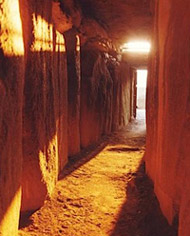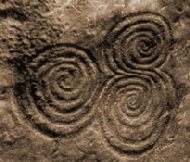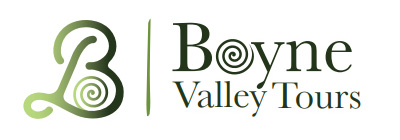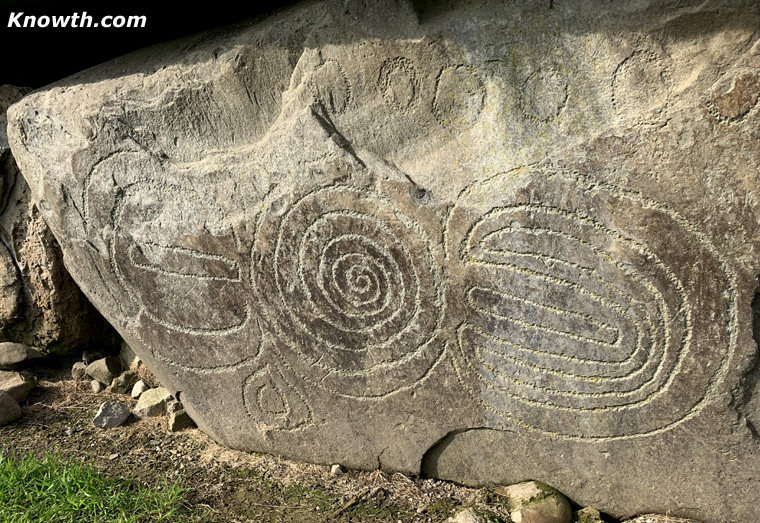Spirals within Spirals, Stones have Stories to Tell
A personal essay by James Nemec (1953-2011)Opening Note
The author of the books Touch the Ocean: The Power of Our Collective Emotions and Journeys: Stories Our Bodies Can Tell visits Knowth. "It was an awakening," he says. "to purpose. Authentic purpose."Newgrange was set up specifically to calibrate the position of the sun at the time of the Winter Solstice. And after all the many theories, ideas, about Newgrange and Knowth, what is it to appreciate the beauty of these ancient places in a fresh, new way? What can happen when we can approach these places with a sense of invitation in utmost respect? Don't forget to bring along your sense of humour! When we take ancient sites too seriously there is much that we can miss!
Dedicated to the Wisdom of the Ancients and the People of Ireland
With A Light Touch: Spiralling Impressions from Knowth to the Joyce Tower
"Everybody loves somebody but God loves Everybody."
James Joyce, Ulysses
With A Light Touch: Spiralling Impressions from Knowth to the Joyce Tower
"Everybody loves somebody but God loves Everybody."
James Joyce, Ulysses
My journal says that it starts in this century, at the Dublin Writer's Museum. I went up the stairs and looked in the glass cases filled with open books. I looked at the opening pages of Ulysses by James Joyce. I had forgotten the book started in a stone tower. The tower was once a military installation that supported a long gun that could site Dublin Bay and the land around the town of Sandycove. It was now a museum, properly called, The James Joyce Tower & Museum.
I had forgotten about the character, Buck Milligan and about his shaving kit too. Stately, plump, Buck Milligan. I recalled Joyce's earlier book, Portrait of the Artist as a Young Man from my reading in college, and how the opening lines of that book described the entire portrait to follow in shorthand. It had been an experiment in writing on Joyce's part, my college professor had said. Now, I wondered if the structure of the book, Ulysses might be based around its first scene too, not the words so much as the fellows going up and down the winding staircase of the stone tower. What was it about that staircase? I thought of stairways, nautilus shells and of spirals. I flipped a page in my worn, leather journal and read about the view of the Bay once I'd ascended the top of the Tower.
After my visit to the Visitor Centre at Newgrange, and the ancient mound of Knowth, north of Dublin, I was compelled to go to the Joyce Tower, itself a pilgrimage. I had to find out more of what had happened to me at Knowth.
"Not to." Even when I first met her in Panama, the year before, Eileen had said she had been to Newgrange for the Winter Solstice celebration there. I wasn't really into Winter Solstice celebrations, but it wasn't winter. This was the height of summer in Ireland and hot. It was my first time here. I had landed a few days before at her place in the north of Dublin near Howth Castle and just wanted to see the countryside.
"Sure," I said. "What can I learn today?" Cosmic consciousness was the last thing I'd expected to happen on my visit to Ireland! Eileen was enthusiastic. We took the ride out of the busy Dublin traffic in her lovely Alfa Romeo and travelled north for little more than an hour. Eileen has a true Irish heart of gold. Her straight auburn hair flew in the wind and her light eyes grew even clearer the closer we got to Newgrange.
She couldn't stop talking about her times there before. She said there was a lottery now for those who wanted to go to the Solstice celebrations. "A lottery?" I said. "Some ancient ritual?" She said, "No! Go on!" I let her know that I respected the place, although I'd never really studied it. Since college, I'd known it was the first major structure that had been built on top of the Earth after our species departed the caves. Newgrange, and the mounds around it, were older than the pyramids by almost 600 years.
Newgrange was closed.
How could a World Heritage Site be closed? I thought. We'd gotten there too late. Eileen was somewhat disappointed. There were two women at the visitors' desk at the Brú na Bóinne Visitor Centre who kindly told us that Knowth was still open. Knowth? I'd never heard of it. I was a playwright interested in the literature of Ireland. Since playwrights are not paid to write in the United States, as many of them are in Ireland, I made my living as a massage therapist and practitioner of light touch therapies in complimentary medicine. I didn't have the patience for this. Eileen steered me away from the desk. She knew that for all my good intentions, I could speak out of turn on occasion, especially to officials. This is not always in my favour.
"We can wait, Mr. Blue Eyes."
I had met Eileen when she and I were working in a little known hands-on modality called, "craniosacral therapy." (Say that 3 times fast without smiling!) Eileen and I had been doing this very special form of therapy in the ocean with villagers in Panama during a seminar there. Craniosacral Therapy is kind of cross between massage therapy and chiropractic. The touch is light, gentle, and non-intrusive that it can be performed on newborns and on the elderly. Not too many years before, we had found it could also be performed in water and in the ocean.
If I may, CranioSacral Therapy uses a very light touch to access the little known craniosacral system, a physiological system which surrounds, supports, and cushions the central nervous system. It forms a tough membranous sheath around the brain and spinal cord. It continually bathes the central nervous system with a nurturing and nourishing fluid called, cerebrospinal fluid (csf). Craniosacral Therapy students learn how to use a light, high intentioned touch to access and unlock the flows of cerebrospinal fluid (csf) in the deeper meningial membrane structures surrounding the brain and spinal cord.
All forms of craniosacral are originally derived from the findings of osteopathic physician, Dr. William Garner Sutherland, and date back to 1901. In the more recent history, this leading edge modality was expanded and developed by others, notably by osteopath, Dr. John E. Upledger, who called it, "craniosacral therapy," with the Upledger Institute based in South Florida in the town of Palm Beach Gardens. I had been doing craniosacral therapy with dolphins and clients in therapeutic seminars in the Bahamas for some years before my visit to Ireland, under the auspices of the Upledger Institute.
As my day-job, I had also been doing this with clients in clinical environments and on my own in the South Florida ocean for a number of years and had even written a book or two on the subject. After working with dolphins, therapeutically, something opens and the world is no longer the same. There would be little difference in being with dolphins and being with the ancient carved stones during my short afternoon visit to Knowth, as you will see. This continues to astonish me. If this could happen with me, could it happen with anyone?
Now, I was here visiting in Ireland to be part of a healing team to contribute this new form of therapy, craniosacral therapy, to others in the West, south of Galway, near Lahinch. My new friend and hostess, Eileen, would be part of this specialized, international team and we had six days to tour before the seminar work would begin. Eileen couldn't remember when she'd visited this other site, the ancient mound of Knowth. For her, it had always been Newgrange. Not knowing what else to do, I wandered off into the museum part of the Centre. Eileen followed me, perhaps to keep me in line. Anyway, it was something to do while we waited for the tour bus to take us to Knowth.
Those who have been to the Brú na Bóinne Visitor Centre know there is a life-size display of the Newgrange mound and a movie provided for tourists with seating in the round. We'd watch a movie first. I was already struck by the number of photographs of megalithic spirals on the museum walls.
"What are these spirals?"
"They're from the mounds," said Eileen.
All I could manage to say was, "The mounds?"
Eileen had told me, time and again, how a single ray of light from the sun on the
Winter Solstice
would go through a small opening outside the mound to light up the far burial chamber deep within.
I couldn't make sense of it, or why so many people would gather there each year.
With the photographs of the spirals, the mystery deepened.
"They're from the mounds," said Eileen.
All I could manage to say was, "The mounds?"
 As
I sat in the quiet of the circular movie theatre and saw image after image of Newgrange,
I began to contemplate the contributions of osteopathic physician, Andrew Still.
Sutherland had been influenced by Dr. Andrew Still, the father of osteopathy and the creator
of the first school of osteopathy, the American School of Osteopathy in Kirksville, Missouri.
Dr. Still had asked this question: How could we get sick in one part of our body without the
rest of our body being affected? It just didn't make sense to him, otherwise. He grew up
in farm country and could observe that if one part of a summer crop was blighted, the whole
field might have to be treated, not just the part.
As
I sat in the quiet of the circular movie theatre and saw image after image of Newgrange,
I began to contemplate the contributions of osteopathic physician, Andrew Still.
Sutherland had been influenced by Dr. Andrew Still, the father of osteopathy and the creator
of the first school of osteopathy, the American School of Osteopathy in Kirksville, Missouri.
Dr. Still had asked this question: How could we get sick in one part of our body without the
rest of our body being affected? It just didn't make sense to him, otherwise. He grew up
in farm country and could observe that if one part of a summer crop was blighted, the whole
field might have to be treated, not just the part.
Dr. Still later felt inspired to treat the body as a unified whole, a unit, and so began the science of osteopathy, "osteo" from the Greek, meaning "bone." He had also observed, as had other legendary figures in the medical science of the time, that, as miraculous as it may seem, the body had a marvellous ability to correct itself, and this continues to be referred to as the "self corrective mechanism," or, the "self-corrective ability" of the body. Naturally, this is what the body does to maintain its essential balance, or, homeostasis, each moment of every day.
Dr. Still was determined to trust in the self corrective ability of the body, and rather than interfere with it, found ways to support it. The body could find its way back to health and harmony mostly on its own, if given the chance. He would trust the body to know the way. And he would trust in the inherent wisdom of the body, not just the mind. These remain revolutionary ideas in Western Medicine today, more than a hundred years later!
When a craniosacral practitioner relieves and treats a body for asthma, depression, Post-Traumatic-Stress-Syndrome (PTSD), migraines, or even chronic lower back pain, he/she doesn't treat just the part, but the part AND the whole. This is one reason why craniosacral therapy works, where conventional thought and medicine fails to successfully treat and relieve all of the same symptoms -- at least this has been my experience of those who come into my office for relief in the USA. In the darkness of the circular movie theater, I was thinking: All these parts add up to the parts of a whole. These mounds are not random, isolated expressions or independent of each other. They add up to a whole.
And what of these spirals?
 Again,
I'd just written a book in the United States 'Touch the Ocean' and was also
here in Ireland to present the book at locations in Dublin and Cloughjordan.
The book describes how when doing craniosacral therapy with clients in the ocean,
the body can often let go of angst and other emotional debris while spontaneously
moving in a spiral along the surface of the water. I had once thought that the
clients my hands had held in the ocean had been moving through the water in
wider and wider circles, and it wasn't long before I wrote the book that I
realized these circles were actually spirals.
Again,
I'd just written a book in the United States 'Touch the Ocean' and was also
here in Ireland to present the book at locations in Dublin and Cloughjordan.
The book describes how when doing craniosacral therapy with clients in the ocean,
the body can often let go of angst and other emotional debris while spontaneously
moving in a spiral along the surface of the water. I had once thought that the
clients my hands had held in the ocean had been moving through the water in
wider and wider circles, and it wasn't long before I wrote the book that I
realized these circles were actually spirals.
I had observed something similar when working with the clients and dolphins in the Bahamas. I'd by now speculated that dolphins breathe in spirals, breathing air through their blow-holes in a series of spirals which also allows them to make their unusual but very specific sounds. Spirals seemed to be everywhere here. There were studies now that spirals were part of the movement of black holes in the Universe. As I sat with the other tourists in the movie theatre, I wondered why was there so much importance placed on these earth structures as only having been burial mounds? I learned that there were only a few hundred remains found in the mounds of Knowth and Newgrange. This somehow didn't add up. Something more seemed to be going on here, I didn't know what.
As a playwright, I'm always going to the meaning behind the words and the actions that an actor makes onstage. I'm intrigued with the structure of plays and stories. As a healing artist, I'm doing this also but with my hands on another person's body. I went deeper in my contemplation and considered the esoteric literature of the early Christian desert fathers, that of India, Buddhism.
Boyne Valley Private Day Tour
 Immerse yourself in the rich heritage and culture of the Boyne Valley with our full-day private tours.
Visit Newgrange World Heritage site, explore the Hill of Slane, where Saint Patrick famously lit the Paschal fire.
Discover the Hill of Tara, the ancient seat of power for the High Kings of Ireland.
Book Now
Immerse yourself in the rich heritage and culture of the Boyne Valley with our full-day private tours.
Visit Newgrange World Heritage site, explore the Hill of Slane, where Saint Patrick famously lit the Paschal fire.
Discover the Hill of Tara, the ancient seat of power for the High Kings of Ireland.
Book Now
Home
| Newgrange
| Knowth
| Dowth
| Hill of Tara
| Fourknocks
| Loughcrew
| More Places
| Labyrinths
| Local Info
| Art Works
| Articles
| Images
| Books
| Links
| Boyne Valley Tours
| Contact


